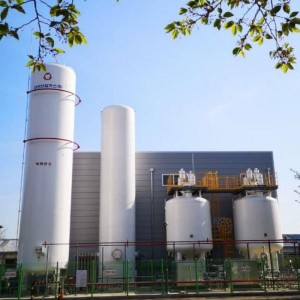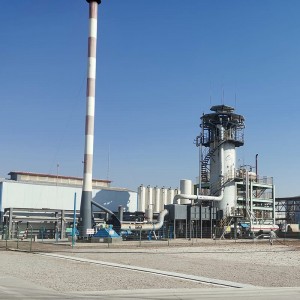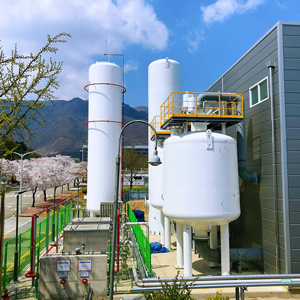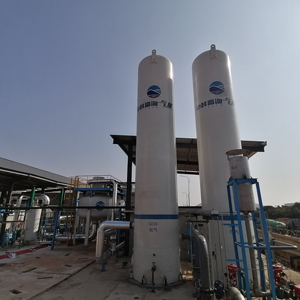- Typical feed: Air
- Capacity range: 5~3000Nm3/h
- N2 purity: 95%~99.999% by vol.
- N2 supply pressure: 0.1~0.8MPa(Adjustable)
- Operation: Automatic, PLC controlled
- Utilities: For the production of 1,000 Nm³/h N2, the following Utilities are required:
- Air consumption: 63.8m3/min
- Power of air compressor: 355kw
- Power of nitrogen generator purification system: 14.2kw
The working principle of vacuum pressure swing adsorption oxygen Plant (VPSA O2 Plant) is to use lithium molecular sieve to selectively adsorb the nitrogen in the air, so that oxygen is enriched at the top of the adsorption tower as a product gas output. The whole process includes at least two steps of adsorption (low pressure) and desorption (vacuum, that is, negative pressure), and the operation is repeated in cycles. In order to continuously obtain oxygen products, the adsorption system of the VPSA oxygen production unit is composed of two adsorption towers equipped with molecular sieve (assume tower A and tower B) and pipeline and valves.
The compressed air is filtered and into tower A, then the oxygen is collected to the top of the adsorption tower A as product gas output. At the same time, Tower B is in the regeneration stage, when tower A is in adsorption process tends to adsorption saturation, under the control of the computer, the air source turns into Tower B and enter the adsorption oxygen production process. The two towers cooperate in the cycle to achieve continuous oxygen production.
The VPSA O2 Plant Technical Features
Mature technology, safe and reliable
Low power consumption
High automation
Cheap operation cost
The VPSA O2 Plant Specifications
|
Oxygen capacity |
Load adjustment |
Water Consumption |
Power Consumption |
Floor area |
|
1000 Nm3/h |
50%~100% |
30 |
according to specific conditions |
470 |
|
3000 Nm3/h |
50%~100% |
70 |
according to specific conditions |
570 |
|
5000 Nm3/h |
50%~100% |
120 |
according to specific conditions |
650 |
|
8000 Nm3/h |
20%~100% |
205 |
according to specific conditions |
1400 |
|
10000 Nm3/h |
20%~100% |
240 |
according to specific conditions |
1400 |
|
12000 Nm3/h |
20%~100% |
258 |
according to specific conditions |
1500 |
|
15000 Nm3/h |
10%~100% |
360 |
according to specific conditions |
1900 |
|
20000 Nm3/h |
10%~100% |
480 |
according to specific conditions |
2800 |
| * The reference data is based on oxygen purity 90%* The VPSA oxygen production process implements “customized” design according to the user’s different altitude, meteorological conditions, device size, oxygen purity (70%~93%). | ||||
(1) VPSA O2 Plant Adsorption Process
After being boosted by roots blower, feed air will be directly sent to the adsorber in which various components (e.g. H2O, CO2 and N2) will be successively absorbed by several adsorbents to further obtain O2 (the purity may be adjusted through the computer between 70% and 93%). O2 will be output from the top of the adsorber, and then delivered into the product buffer tank.
According to customer requirements, different types of oxygen compressors can be used to pressurize the low-pressure product oxygen to the target pressure.
When the leading edge (termed as adsorption leading edge) of the mass transfer zone of absorbed impurities reaches a certain position at the reserved section of the bed outlet, the feed air inlet valve and the product gas outlet valve of this adsorber shall be shut off to cease absorption. The adsorbent bed begins to shift to the equal-pressure recovery and regeneration process.
(2)VPSA O2 Plant Equal-Depressurize Process
This is the process in which, after the completion of the adsorption process, relatively high pressure oxygen enriched gases in the absorber are put into another vacuum pressure adsorber with the regeneration finished in the same direction of adsorption This is not only a pressure reduction process but also a process of oxygen recovery from the dead space of the bed. Therefore, oxygen can be fully recovered, so as to improve the oxygen recovery rate.
(3) VPSA O2 Plant Vacuumizing Process
After the completion of pressure equalization, for radical regeneration of the adsorbent, the adsorption bed may be vacuumized with a vacuum pump in the same direction of adsorption, so as to further reduce the partial pressure of impurities, fully desorb adsorbed impurities, and radically regenerate the adsorbent.
(4) VPSA O2 Plant Equal- Repressurize Process
After the completion of the vacuumizing and regeneration process, the adsorber shall be boosted with relatively high pressure oxygen enriched gases from other adsorbers. This process is corresponding to the pressure equalization and reduction process, which is not only a boosting process but also a process of oxygen recovery from the dead space of other adsorbers.
(5) VPSA O2 Plant Final Product Gas Repressurizing Process
After Equal- depressurize process, to make sure the stable transition of the adsorber to the next absorption cycle, guarantee the product purity, and reduce the fluctuation range in this process, it is necessary to boost the pressure of the adsorber to the absorption pressure with product oxygen.
After above process, the whole cycle of “absorption – regeneration” is completed in the adsorber, which is ready for the next absorption cycle.
The two adsorbers will work alternatively according to specific procedures, so as to realize continuous air separation and obtain product oxygen.




















